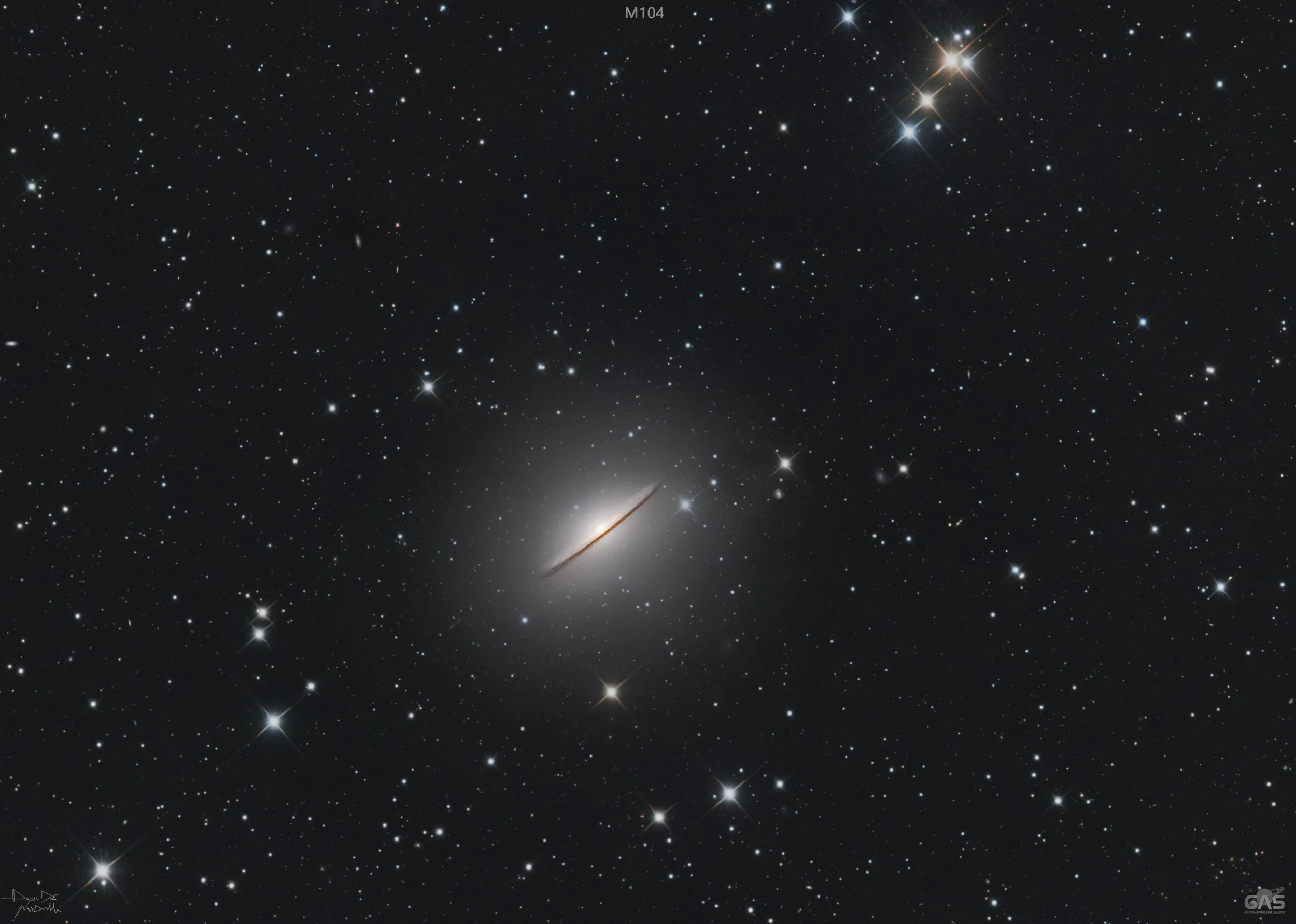
AAPOD2 Image Archives
Sort 2025 By Month: January | February | March | April | May | June | July | August | September | October | November | December
M104 Sombrero Galaxy widefield
In this wide-field image, the somber beauty of the Sombrero Galaxy, also known as Messier 104 (M104), graces the night sky. Situated in the constellation Virgo, this stunning spiral galaxy captivates with its prominent dust lane that wraps around its bulging core, resembling the brim of a wide-brimmed hat.
M104 lies approximately 28 million light-years away from Earth and harbors a supermassive black hole at its center. Its distinctive appearance and unique structure make it a fascinating subject for astronomers and astrophotographers alike. This image offers a glimpse into the vastness of our universe and serves as a testament to the intricate beauty found in the cosmos.
NGC 4216 and Friends
NGC 4216, nestled within the constellation of Virgo, is a beautiful barred spiral galaxy situated about 40 million light-years away from Earth. It is part of the vast Virgo Cluster, a rich gathering of galaxies bound together by gravity. In this cosmic neighborhood, NGC 4216 is not alone; it shares its celestial surroundings with a host of neighboring galaxies, forming a captivating ensemble of cosmic companions.
Among its companions are several other galaxies, each with its own unique features and characteristics. These celestial neighbors contribute to the rich tapestry of the Virgo Cluster, offering astronomers valuable opportunities to study the dynamics and interactions within this galactic community. By observing NGC 4216 and its companions, scientists can unravel the complex processes shaping the evolution of galaxies and gain deeper insights into the vast cosmic web of which we are a part.
SH2-224 Supernova Remnant
SH2-224, nestled in the northern constellation of Auriga, emerges as a captivating supernova remnant, approximately 14,700 light-years distant from our solar system. This celestial marvel presents an unconventional shape, resembling a paddy field or gendarme hat, owing to its intricate shell structure interacting with the surrounding interstellar medium.
The enigmatic nature of SH2-224 unfolds through its interactions with a cavity in the interstellar medium, distinguished by its higher temperature compared to the surrounding environment. Through meticulous X-ray studies, astronomers estimate the age of this structure to be between 13,000 and 24,000 years, offering insights into the dynamics of stellar evolution and interstellar interactions.
Captured over the span of 33 hours, this remarkable image of SH2-224 reveals the delicate balance between two interacting gases: the reddish hues of hydrogen and the ethereal green tones of oxygen. Utilizing narrowband filters for hydrogen-alpha and oxygen III, complemented by broadband RGB sessions, the intricate details of the supernova nucleus and surrounding stars are brought to life with vibrant color and depth. As SH2-224 continues to captivate astronomers and enthusiasts alike, it stands as a testament to the enduring beauty and complexity of the cosmos, inviting us to delve deeper into its mysteries.
Markarian's Chain
Markarian's Chain, a prominent feature in the Virgo Cluster, is a gravitational ballet of galactic proportions. Comprising a series of interacting galaxies linked by the force of gravity, this cosmic necklace spans the Virgo Cluster's core, captivating astronomers and stargazers alike with its mesmerizing allure.
This RGB image captures the intricate details of the galaxies within Markarian's Chain, each one a celestial jewel with its unique shape and structure. The gravitational interactions between these galaxies have given rise to stunning tidal tails and bridges, a testament to the complex dynamics shaping their shared cosmic destiny.
Situated roughly 50 million light-years away, Markarian's Chain provides a remarkable glimpse into the rich galactic diversity present in the Virgo Cluster. As part of the larger Virgo Supercluster, this cosmic ensemble invites contemplation of the vast cosmic structures that govern the distribution of galaxies across the cosmos.
The Seven Sisters
M45, commonly known as the Pleiades or the Seven Sisters, presents a captivating celestial panorama with distinctive blue hues in astrophotographs. The dominant reason behind this intense blue appearance lies in the interstellar dust surrounding the stars within the cluster. As starlight passes through this cosmic dust, it undergoes a process known as Rayleigh scattering.
Rayleigh scattering, more commonly associated with why the Earth's sky appears blue during the day, occurs when short wavelengths of light (such as blue) scatter more effectively than longer wavelengths (such as red). In the case of the Pleiades, the blue light from the stars is scattered by the intervening interstellar dust, resulting in the cluster's pronounced blue coloration when captured through astrophotography.
This scattering phenomenon not only contributes to the distinct visual beauty of the Pleiades but also serves as a valuable astrophysical tool for astronomers. By studying the extent of this scattering, scientists can gain insights into the distribution and properties of the intervening interstellar material, providing a deeper understanding of the cosmic environment surrounding this iconic star cluster.
NGC 2903 - Galaxy in "Leo"
NGC 2903 is a barred spiral galaxy situated in the constellation Leo, approximately 20.5 million light-years away from our location. Discovered by William Herschel and cataloged on November 16, 1784, this galaxy bears a striking resemblance to our own Milky Way. It boasts a size slightly smaller than our galaxy, with a diameter spanning around 80,000 light-years.







